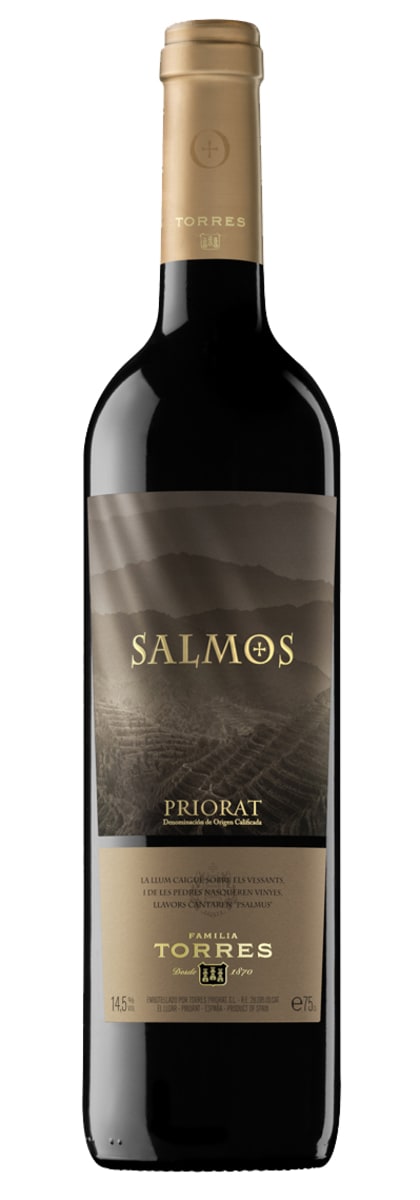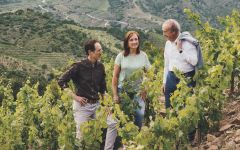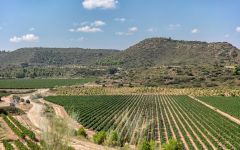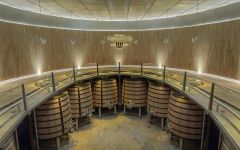Familia Torres Salmos 2017
-
James
Suckling -
Robert
Parker




Product Details
Your Rating
Somm Note
Winemaker Notes
Brilliant ruby red in color with garnet highlights. Astounding rose and black cherry aroma with aromatic herbs such as thyme coming through. Lively and light-bodied on the palate, full of personality, well structured with pleasant tannins and a streak of acidity that promises a long future.
Professional Ratings
-
James Suckling
A beautiful red with rather flamboyant fruit, showing crushed berries, flowers and some chocolate and walnut undertones. It’s full-bodied and layered. Creamy texture. Drink or hold.
-
Robert Parker's Wine Advocate
A ripe red from Priorat, the 2017 Salmos is a blend of 50% Cariñena, 40% Garnacha and 10% Syrah with a mixture of berry and spicy oak aromas and limited Priorat character. It's polished and balanced, and the tannins are fine-grained.
Other Vintages
2018-
James
Suckling
-
James
Suckling -
Wine
Spectator - Decanter
-
Wine
Enthusiast -
Robert
Parker
-
Wine
Spectator -
Wine &
Spirits
-
Wilfred
Wong -
Wine
Enthusiast -
Wine
Spectator
-
James
Suckling -
Robert
Parker
-
Wine &
Spirits -
Wine
Spectator
-
Wine &
Spirits






In 2020, Familia Torres Winery is celebrating their 150th anniversary, but the family’s roots extend even farther than that. The first mention of the Torres wine family was in 1557, but the winery wasn’t established until 1870, when the profits from the family shipping company made it possible to enter the commercial wine space.
Miguel Torres Vendrell founded the company, and since then, the family has passed on the winery (and the name Miguel) steadfastly from generation to generation. They hit a setback when the winery was bombed during the Spanish civil war, but Miguel Torres i Carbó rebuilt, and began the bottling and exporting of the wine.
In 1991, Miguel A. Torres took the reigns, and remains president today. He made remarkable strides in environmental advocacy, social responsibility, fair trade, and research and innovation. Since 2012, Miguel Torres Maczassek has been at the helm, and has continued his father’s work, while also embarking on his own projects. Recognized year after year and Drinks Internationals’ “World’s Most Admired Wine Brand,” the story of Familia Torres is a known and respected one throughout Spain and the world.
Juan Torres Master Distillers is the spirits division of Familia Torres. Its origins date back to 1928 when Juan Torres Casals of the family’s second generation began making aged brandies matured in oak casks; smooth and aromatic spirits distilled from a selection of the finest white Penedès (Barcelona) wines. With 90 years to its name, Juan Torres Master Distillers continues to perfect the art of distillation to this day – a constant pursuit of excellence that finds reflection in each one of its ten, exquisitely crafted spirits, including brandy, pisco, and orange liqueur produced under the brands Torres Brandy, El Gobernador, and Magdala. These elegant, personality-driven spirits find their perfect match in the world of mixology, where they live up to the expectations of a new consumer who delights in shared moments of superior quality.

With hundreds of red grape varieties to choose from, winemakers have the freedom to create a virtually endless assortment of blended red wines. In many European regions, strict laws are in place determining the set of varieties that may be used, but in the New World, experimentation is permitted and encouraged resulting in a wide variety of red wine styles. Blending can be utilized to enhance balance or create complexity, lending different layers of flavors and aromas. For example, a red wine blend variety that creates a fruity and full-bodied wine would do well combined with one that is naturally high in acidity and tannins. Sometimes small amounts of a particular variety are added to boost color or aromatics. Blending can take place before or after fermentation, with the latter, more popular option giving more control to the winemaker over the final qualities of the wine.
How to Serve Red Wine
A common piece of advice is to serve red wine at “room temperature,” but this suggestion is imprecise. After all, room temperature in January is likely to be quite different than in August, even considering the possible effect of central heating and air conditioning systems. The proper temperature to aim for is 55° F to 60° F for lighter-bodied reds and 60° F to 65° F for fuller-bodied wines.
How Long Does Red Wine Last?
Once opened and re-corked, a bottle stored in a cool, dark environment (like your fridge) will stay fresh and nicely drinkable for a day or two. There are products available that can extend that period by a couple of days. As for unopened bottles, optimal storage means keeping them on their sides in a moderately humid environment at about 57° F. Red wines stored in this manner will stay good – and possibly improve – for anywhere from one year to multiple decades. Assessing how long to hold on to a bottle is a complicated science. If you are planning long-term storage of your reds, seek the advice of a wine professional.

Tiny and entirely composed of craggy, jagged and deeply terraced vineyards, Priorat is a Catalan wine-producing region that was virtually abandoned until the early 1990s. This Spanish wine's renaissance came with the arrival of one man, René Barbier, who recognized the region’s forgotten potential. He banded with five friends to create five “Clos” in the village of Gratallops. Their aim was to revive some of Priorat’s ancient Carignan vines, as well as plant new—mainly French—varieties. These winemakers were technically skilled, well-trained and locally inspired; not surprisingly their results were a far cry from the few rustic and overly fermented wines already produced.
This movement escalated Priorat’s popularity for a few reasons. Its new wines were modern and made with well-recognized varieties, namely old Carignan and Grenache blended with Syrah, Cabernet Sauvignon and Merlot. When the demand arrived, scarcity commanded higher prices and as the region discovered its new acclaim, investors came running from near and far. Within ten years, the area under vine practically doubled.
Priorat’s steep slopes of licorella (brown and black slate) and quartzite soils, protection from the cold winds of the Siera de Monstant and a lack of water, leading to incredibly low vine yields, all work together to make the region’s wines unique. While similar blends could and are produced elsewhere, the mineral essence and unprecedented concentration of a Priorat wine is unmistakable.
